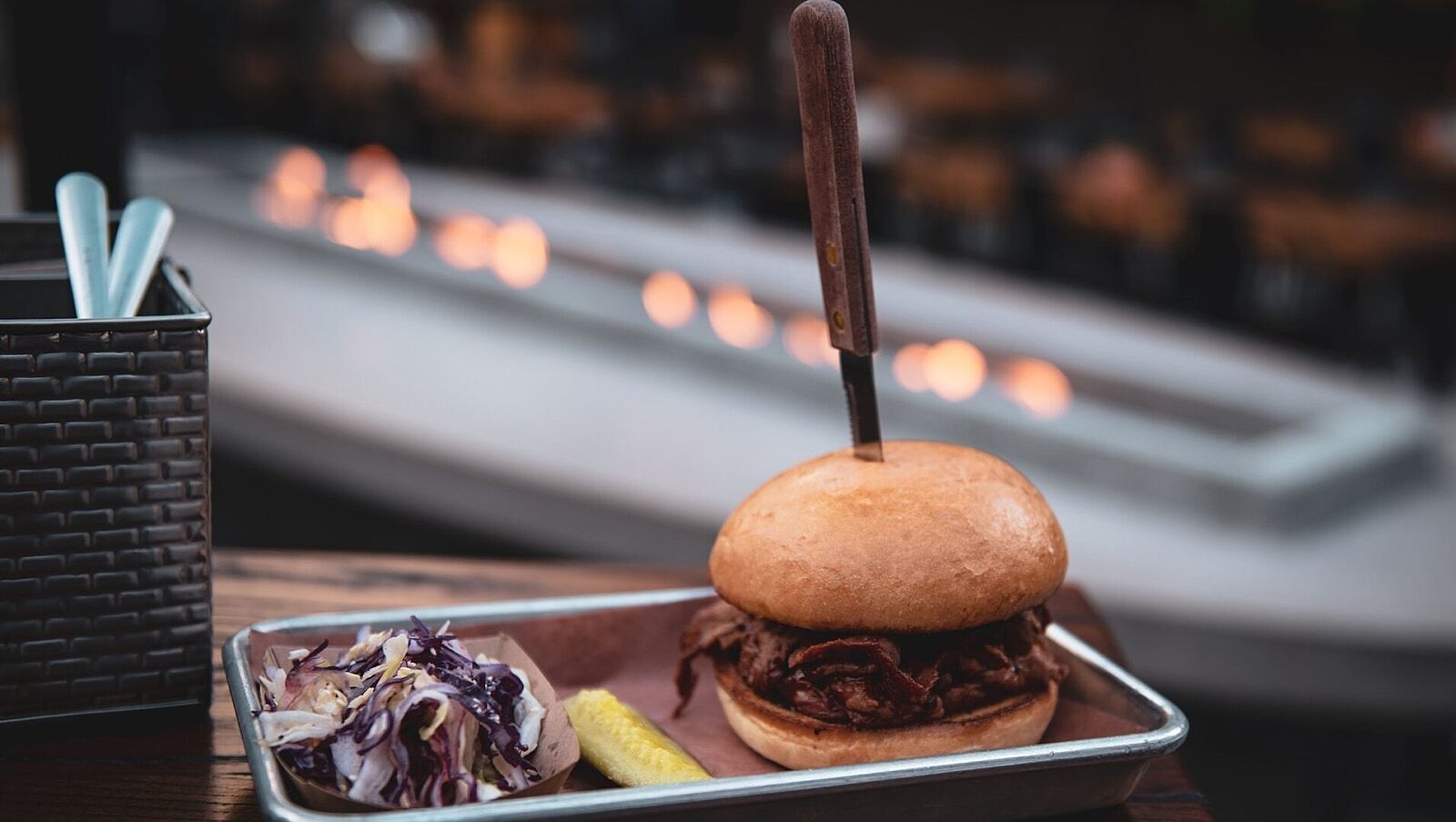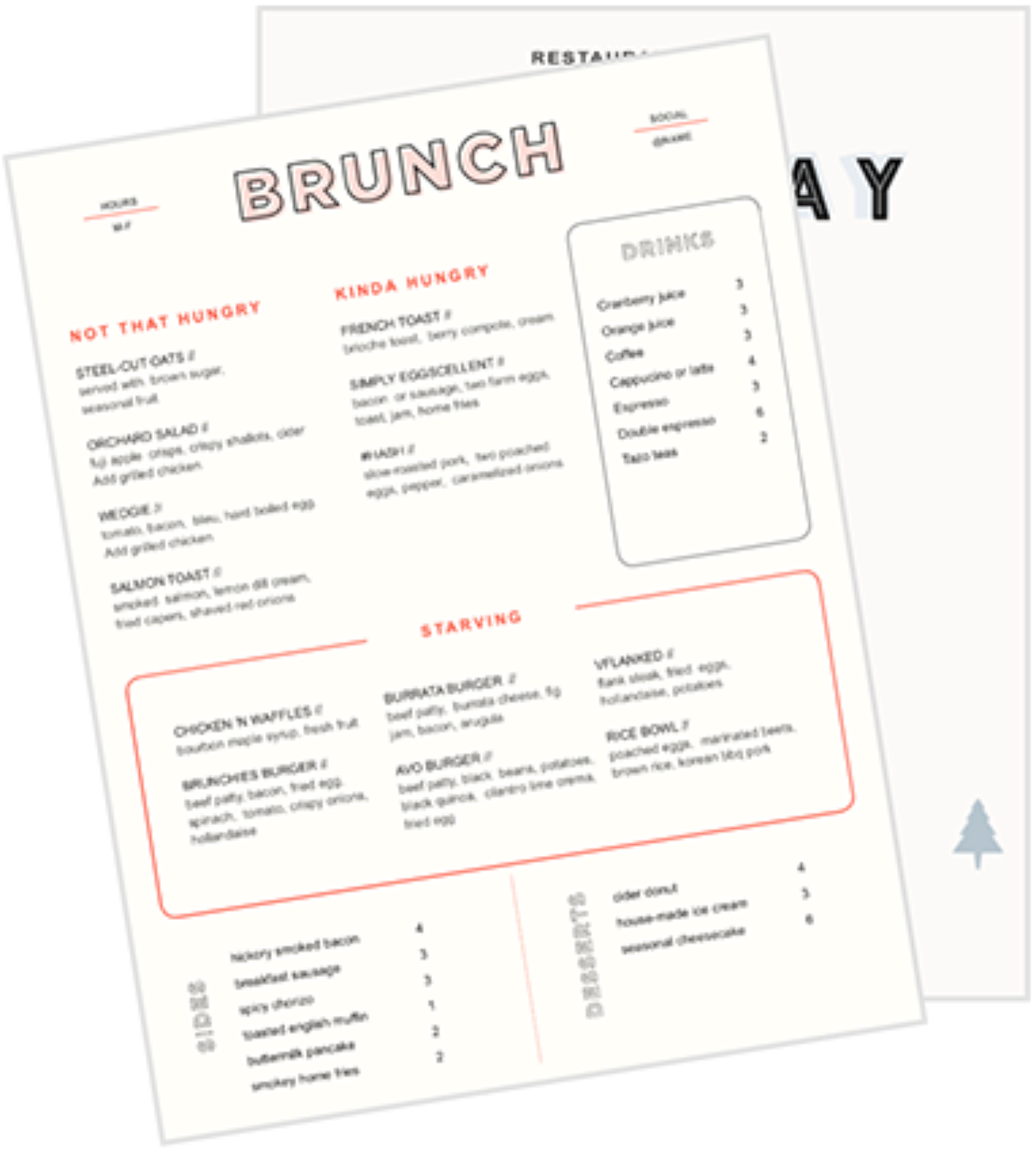
How to Make a BBQ Menu Design With Examples (Free Template)
Turn every day into the cookout of your dreams with these ten simple steps for creating a BBQ restaurant menu.
Tyler MartinezAuthor


Restaurant Menu Templates
Use these menu templates as a starting point for your menu design or to give your menus a refresh.
Get free downloadHow to Create a BBQ Menu
BBQ menus, whether printed, online, or on menu boards, are powerful drivers of sales for BBQ restaurants. They are a central part of the guest experience and streamline the customer service process.
Design your printed menus, online menus, and menu boards using this 10-step process. We provide tips on how to develop menus, example menus, and free, customizable restaurant menu templates.
The Power of Good Menu Design
Great menus can boost sales, but menu design missteps can hurt your restaurant or restaurant’s sales and profitability. When listing menu items, draw customers' attention to the most profitable plates.
Menus are your service staff’s best-selling tool. List modifiers, such as adding an extra link of sausage to a platter, right on the menu. That will tempt customers and create opportunities for sales.
In each menu design, keep your brand’s unique aesthetic front and center. Consult the examples we provide at the end of this article. Use our templates, worksheets, and guides to create menus that drive a cohesive, memorable guest experience.
Menu Engineering Course
Take this course to make the most of your menu. Learn about menu psychology and design, managing your menu online, and adapting your menu to increase sales.

How to Make a BBQ Menu
There is a perfect menu for every BBQ restaurant. Designing menu boards, online menus, or printed menus that are appropriate for your restaurant requires careful decision-making.
This 10-step process will guide you to build BBQ menus or give you some insight into the process when working with a designer. For an even bigger head start, you can apply these steps to our customizable menu templates.
1. Write Out All Menu Items
Start by creating a spreadsheet to organize information about your menu items. Before you get creative, use Excel, Google Sheets, or your favorite spreadsheet program. List out all of the dishes, sides, and sweets that you and your BBQ restaurant offers to guests.
The spreadsheet of menu items will help you to organize the names, costs, and descriptions. Google Sheets autosaves your work, which you can copy/paste into menu templates. Use our template to get started, and don’t forget to download a copy of your work for your records. Be sure to update the names and descriptions of menu items when things change since this document becomes a reference for your menus.
2. Categorize Menu Items
After you create your spreadsheet, create categories for the kinds of menu items that you want to list together. Mains courses, side dishes, appetizers, and desserts are some common categories.
Sometimes, it’s best not to overwhelm customers with options. Dividing menu items into categories can help guests to navigate the menu and easily find their favorites.
As a basic rule, you can draw guests’ attention to a menu item by listing it first in a category. Reserve that first spot for items that you want to sell–those with the biggest profit margin. Our menu engineering worksheet can help in this process.
3. Set Menu Prices
Setting prices for menus is based on a number of factors, such as the business model and profit margins. The complexities of food cost calculations warrant a deep dive. As a food service business owner or stakeholder, it’s worth it to understand how to price menu items. Here are a few general considerations for setting menu prices:
When setting prices for the first time, focus on balancing the price of each menu item with the cost it takes to make it. Do market research and compare prices to get an idea of what local customers are used to paying for similar items.
When you have to reconsider the prices on your BBQ restaurant menu to keep up with inflation or other costs. Analyze the sales data available from your business’s point of sale system and ask yourself if you can tweak prices to make them more appealing to customers.
Sometimes, you have to raise menu prices to provide better pay or benefits to your great staff. Explain the increase in a note to your guests on the menu and website. Let guests know that the small increase supports their favorite workers.
Finally, remember to make decisions based on sales history, inventory, support, labor costs, and the local economy. Our menu engineering course can help new and veteran chefs and restauranteurs alike to use data when pricing menu items. Learn more about creating a menu pricing strategy here.
4. Create Menu Descriptions
BBQ menu items can describe themselves–brisket, smoked sausage, and cornbread need no introduction. But, it’s good to be able to describe menu items to customers. Use precise, clear language and choose adjectives that describe flavor and texture to appeal to the senses–words like smoky, sweet, tangy, zesty, and tender.
Some businesses hire a copywriter for this step, but the best menu descriptions tell the story of your BBQ. Take customers on a journey from the recipe’s origins to its home on your menu. These descriptions add personality to a brand and can be a powerful selling point.
Some information is necessary to include in menu descriptions. Consider how first-time customers will interact with your printed menu, menu boards, and website. Label each item with critical information like allergens and availability.
5. Decide on a Menu Color Scheme
Here comes the fun stuff–deciding on a color scheme and design for your BBQ restaurant menus.
Now that your spreadsheet is completed with categories, descriptions, and prices, start to think about how color and design will communicate your brand’s identity. Choose color schemes that are memorable without being overwhelming.
Colors affect how people interpret your restaurant, as this Chron article on the psychology of restaurant colors shows. Here are a few color resources that designers love:
Adobe Colour CC - color wheel tool
ColorDot - color palette tool
ColRD - color inspiration
The Ultimate Guide to Restaurant Branding
Use this guide to get tips on how to create a restaurant brand that stands out, attracts customers, and drives repeat visits.

6. Design your BBQ Menu
The design of your BBQ menu should be appropriate for your restaurant and match your brand. Menu boards are great for food trucks and fast-casual dining, but sometimes printed menus are the way to go.
Designing menus in-house is a great way to save, but hiring a designer will streamline the process. If you do decide to design your own menus, use design software like Adobe Creative Suite, Canva, or Powerpoint to create designs with that professional finish.
Whether doing it yourself or working with a designer, keep these design best practices in mind. Our menu templates can help you to get started.
The menus should be easy to read. Customers can get overwhelmed by large menus. Keep your offerings to one or two pages to offer just enough options to have something for every guest.
The Golden Triangle. When reading a menu, our eyes start in the middle of the page and then move to the top right and left.
Use dollar signs strategically. Researchers at Cornell found that diners are likely to order more when dollar signs are not on the menu than when they are present. You might remove dollar signs from your menu, and avoid listing prices in a single column which encourages customers to compare them
7. Think about Photos
Photos can be a great way to get customers’ mouths watering, but those photos have to be high-quality and showcase what your guests can expect from each menu item. When it comes to photos, hiring a professional photographer or investing in a digital camera is the way to go.
Before publishing photos on menus or on your website, make sure that the photos are representative of your restaurant’s best work. Photos can also boost your business’s performance on social media. In each post, include a link back to your online menu so that customers can begin an order.
8. Choose Menu Font, Spacing, and Composition
There are hundreds of options for font, spacing, and embellishments for both digital and printed menus. Many restaurants hire designers to help with sorting through all the possibilities.
Designing your own menus for your BBQ restaurant has its advantages. You can keep all of the design elements true to the story of your brand. But don’t be afraid to get a second set of eyes on your designs. You can use our templates and keep all of the design work in-house. Keep your menu consistent enough through redesigns so guests know what to expect.
9. Select the Final Menu Layout
Once you decide on the color scheme, design, font, and photos, it’s time to put all of the elements together. Consult your staff, business partners, and investors to vote on the best menu design for your brand.
Each stakeholder should review the branding, design, menu descriptions, and prices. The more opinions you get, the better idea you will have of how customers will use the menu. Customers have certain expectations of how to interact with a menu, so consider how you can make printed and online menus more user-friendly.
10. Proofread Your Menu
Proofreading is a critical step. Some customers will overlook and forgive spelling and grammar mistakes, but they become distractions to others. Use the built-in spell checker or software like Grammarly to streamline proofreading and catch small mistakes. This can also help you to save by avoiding misprints.
When you’re ready to go to print, consider the paper quality that will give you menus that last for as long as you need them. You can use a local printing shop or an online service like one of the following:
Examples of BBQ Restaurant Menus
Bold and Saucy. The photos on this online menu showcase Smoke BBQ’s mouthwatering sauces and sides.
Minimal and Sleek. With short descriptions and no pictures, this BBQ menu design has no distractions.
Brand-Forward. No one will be able to forget the brand when ordering from Demeris Bar-B-Q with this bright menu design.
Smokehouse Classic. Sometimes, you can’t improve on a nostalgic design. This classic menu gets the job done without the frills and embellishments.
Whimsical and Fun. This design is fun and informative with a unique organization that guides customers through their orders.
Updated vintage. This design feels both dated and timeless. They use menu descriptions strategically to keep the aesthetic clean.
Keep Learning about Menu Engineering
Now that your BBQ restaurant menu is designed and printed, hung, and published online, develop a strategy to keep it up to date. Keep your spreadsheet updated with each menu item that your chefs develop. Share a live copy of that spreadsheet with writers and designers that help you with the process.
Sometimes, it's also necessary to update design elements to keep this fresh and consistent with other brand elements. Our menu engineering spreadsheet will help you analyze the sales performance of each bottle and glass and inform every change to the list.
Related Menu Ideas
- How to Make a Deli Menu
- How to Make a Dessert Menu
- How to Make a Breakfast Menu
- How to Make a Pizzeria Menu
- How to Make a Takeout Menu
- How to Make a Brewery Menu
- How to Make a Wine Bar Menu
- How to Make a Bar Menu
- How to Make a Coffee Shop Menu
- How to Make a Food Truck Menu
- How to Make a Diner Menu
- How to Make a Bakery Menu
- How to Make a Drink Menu
- How to Make a Cocktail Menu
- How to Make a Catering Menu
- How to Make an Ice Cream Shop Menu
- How to Make a Juice Bar Menu
- How to Make a Fine Dining Menu
Menu Engineering Worksheet
Use this menu engineering worksheet, complete with intricate menu engineering formulas, to determine areas of strength and weakness in your restaurant's menu.

Is this article helpful?
DISCLAIMER: This information is provided for general informational purposes only, and publication does not constitute an endorsement. Toast does not warrant the accuracy or completeness of any information, text, graphics, links, or other items contained within this content. Toast does not guarantee you will achieve any specific results if you follow any advice herein. It may be advisable for you to consult with a professional such as a lawyer, accountant, or business advisor for advice specific to your situation.
Read More
Subscribe to On the Line
Sign up to get industry intel, advice, tools, and honest takes from real people tackling their restaurants’ greatest challenges.



